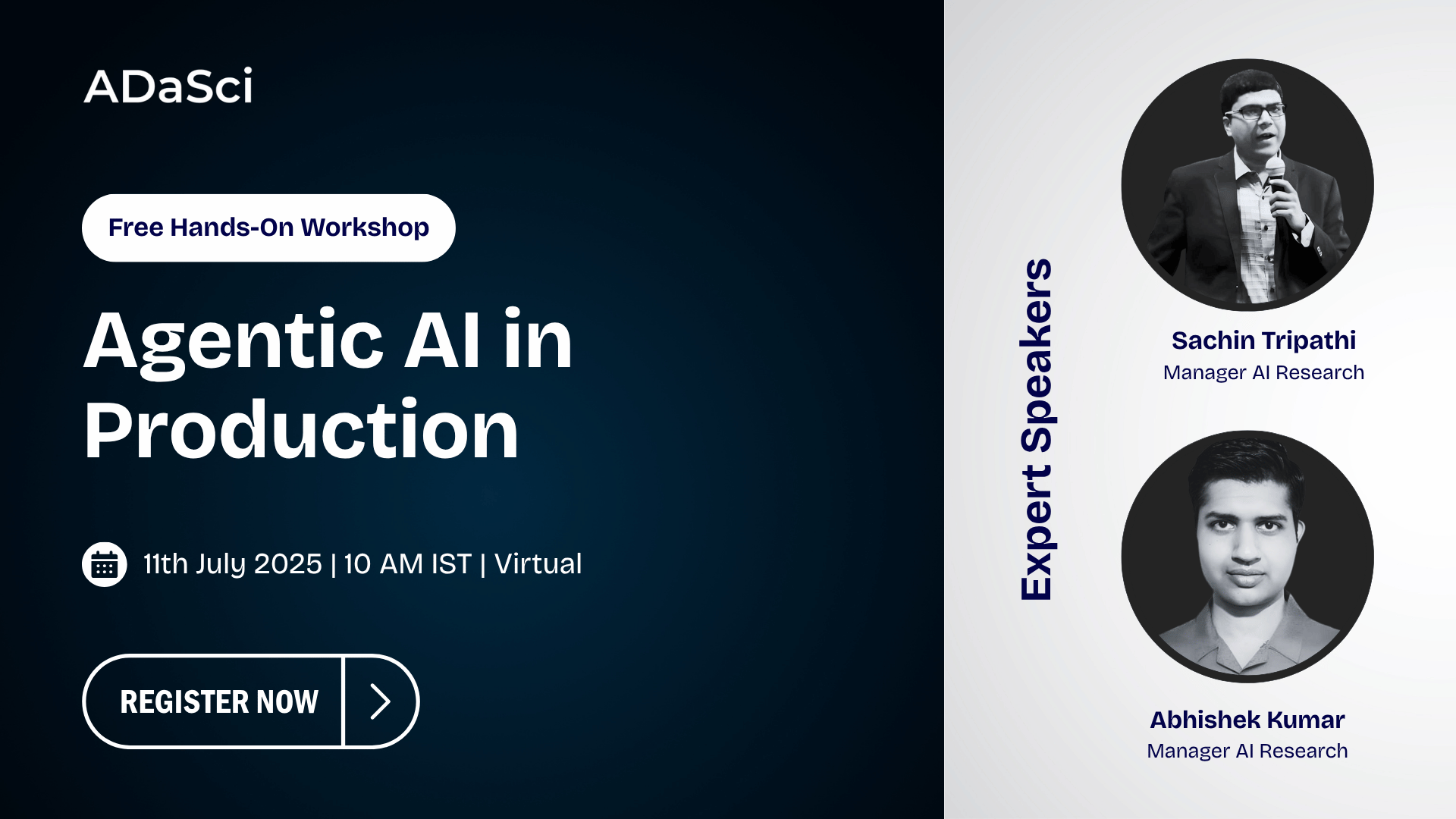All You Need to Know About Multi-Agent Reinforcement Learning

Explore more from ADaSci
Multi-Agent Reinforcement Learning (MARL) is a specialized branch of reinforcement learning (RL) that focuses on scenarios where multiple agents interact within a shared environment to optimize their collective or individual rewards. Unlike traditional RL, which involves a single agent learning in isolation, MARL involves multiple agents that can cooperate, compete, or both. These interactions create a rich, complex environment where agents must adapt to the behavior of others while maximizing their rewards. In this article, we’ll cover the fundamentals of MARL, explore the types of environments in which it operates, address the challenges it presents, and discuss its wide range of real-world applications.
Table of Content
- What is Multi-Agent Reinforcement Learning (MARL)?
- Core Concepts of MARL
- Challenges in MARL
- Types of Environments in MARL
- Applications of MARL
What is Multi-Agent Reinforcement Learning?
At its core, Multi-Agent Reinforcement Learning is an extension of standard reinforcement learning, which involves an agent learning by interacting with an environment to maximize cumulative rewards. In MARL, the environment is shared by multiple agents that can either work together (cooperate), against each other (compete), or adopt a mixed strategy (cooperate with some agents while competing with others). These agents interact in real-time, constantly adjusting their strategies based on their observations of the environment and the actions of the other agents.
In simple terms, MARL involves multiple agents learning in the same space, but their actions and strategies impact not only their own rewards but also the rewards and actions of others.
Core Concepts of MARL
To understand MARL better, let’s break down some key concepts that drive this field:
1. Interaction and Learning
Each agent in a MARL system interacts with the environment and other agents. This interaction leads to what is called a “non-stationary environment.” In single-agent RL, the agent’s learning process is based on a fixed environment, meaning the environment doesn’t change unless the agent does. However, in MARL, each agent’s actions can alter the state of the environment, which, in turn, affects the decisions and outcomes of other agents. This makes the learning process far more dynamic and complex.
2. Shared Reward vs. Individual Reward
In MARL, the rewards can either be shared or individual:
- Cooperative MARL: All agents share a common goal, and the collective reward is maximized. In this setting, agents need to collaborate and synchronize their actions to achieve the best outcome. For example, a team of robots working together to transport goods in a warehouse.
- Competitive MARL: Agents are in competition with each other. Here, each agent tries to outperform the others to achieve the highest individual reward. An example of this would be agents competing in a multiplayer game.
- Mixed MARL: This type involves a combination of cooperation and competition. Agents might cooperate within their teams but compete against other teams. For instance, in a game of soccer, players from the same team cooperate to win the game but compete with the opposing team.

(Multi-agent reinforcement learning schema, source: ResearchGate)
Types of Environments in MARL
The environments in MARL can be classified into different categories based on how agents interact. These include:
a. Cooperative Environments
In cooperative environments, all agents work toward a common goal. The agents must collaborate, share information, and align their strategies to maximize the shared reward. Examples of such environments include multi-robot systems, collaborative search and rescue missions, and traffic management systems where the goal is to reduce congestion.
b. Competitive Environments
In competitive settings, agents compete against each other, and each agent’s success often comes at the expense of the others. Classic examples of competitive environments include multiplayer video games like chess, where the goal is to defeat the opponent, or economic simulations where each agent competes for limited resources.
c. Mixed Environments
Mixed environments blend cooperation and competition. Agents in a team may cooperate with each other, but also compete against agents from another team. Sports games, like soccer, or strategy games, like team-based warfare games, are prime examples where this dynamic exists.
Challenges in MARL
While MARL opens up many exciting possibilities, it also introduces several challenges that make the learning process much more difficult than traditional RL. Some of these challenges include:
a. Non-Stationarity
One of the main challenges in MARL is non-stationarity. In single-agent RL, the environment remains static as the agent learns. However, in MARL, the actions of multiple agents cause the environment to evolve dynamically. This means that when one agent changes its behavior, it affects the learning process of the others, making it harder for each agent to adapt effectively.
b. Scalability
The number of agents in a MARL environment can dramatically increase the complexity of the problem. As more agents are added, the state space (all possible configurations of the system) and the action space (all possible actions the agents can take) grow exponentially. This can lead to slower learning times and greater difficulty in finding optimal solutions.
c. Credit Assignment Problem
In cooperative settings, determining which agent’s actions contributed most to the success of the team is challenging. The credit assignment problem is the challenge of distributing rewards to individual agents in a way that reflects their contributions to the team’s overall success. Solving this problem is essential for effective learning in multi-agent teams.
d. Coordination and Communication
In cooperative MARL, effective coordination and communication between agents are vital. Agents need to be able to share information reliably and synchronize their actions to achieve optimal performance. Lack of communication or misalignment can lead to poor results, even if the agents’ individual strategies are effective.
Applications of MARL
MARL has numerous real-world applications across various domains. Some of the most exciting and promising areas include:
a. Autonomous Vehicles
MARL is used to optimize the interactions between autonomous vehicles, such as improving traffic flow, reducing accidents, and enabling vehicles to navigate in complex environments like city streets. By using MARL, autonomous vehicles can learn to cooperate with each other to optimize driving strategies in a shared space.
b. Robotics
MARL is used in robotics to coordinate multiple robots working together for complex tasks, such as in search-and-rescue operations, automated warehouses, or construction projects. Robots must learn to work together and share resources to complete tasks efficiently.
c. Game AI
MARL has been used extensively in game AI, where multiple agents (either human or computer-controlled) interact within a game environment. This includes applications in both cooperative games (like multiplayer online games) and competitive games (like chess or poker), where agents must adapt their strategies based on other players’ actions.
d. Resource Allocation
In scenarios involving resource allocation, such as energy management systems, MARL can optimize how different agents interact to maximize efficiency. For instance, agents could be used to allocate power resources in a grid, ensuring an optimal distribution based on demand and availability.
Final Words
Multi-Agent Reinforcement Learning represents a significant evolution in AI, offering vast potential in fields that require coordination, competition, or a mix of both. While it comes with challenges such as non-stationarity, scalability, and coordination, the opportunities it presents in fields like autonomous vehicles, robotics, and game AI make it a fascinating area of research and application.
As AI systems become more complex and interdependent, MARL will play a critical role in developing intelligent systems that can navigate real-world challenges where multiple agents interact in dynamic, ever-changing environments.







